04.12.2008 | 6:10 am
A Note from Fatty: This post — rescued from my MSN Spaces Archive — was originally published October 14, 2005.
In February of 2003, a neighbor of mine (John) and I ran the Death Valley Marathon. I figured that since I — theoretically, at least — was going to do an offroad marathon as part of the Mountain Extreme Triathlon that summer [note: I chickened out], I’d better have done at least one marathon beforehand. Since this was to be an all-offroad marathon, it seemed like a good choice.
John and I took Friday off from work, because we figured Death Valley — 2 1/2 hours out of Las Vegas — would be around a 10-hour drive from Orem. Well, there aren’t a lot of curves in that road, not a lot of reasons to go slow, and I have a car that likes going fast. We got there in under 8 hours. We had plenty of time for a little siteseeing (the Devil’s Golf Course is the most surreal thing I have ever seen), a big dinner, and then off to bed. We’d need to be up early for the race.
Saturday morning we got our race bibs and then gathered around the race director for his race instructions. "I was in charge of marking the course," he said, "And I took great care marking all the turns and mile markers." Lots of laughs came from the crowd, which I didn’t understand. Then he said, "Just kidding. There are no mile markers, there are no turns. There’s just one, long road with a finish line at the end." Then he said, "If you want to stop and take some pictures along the way, go ahead and pause your stopwatch. When you get to the finish line, we’ll adjust your time for you." I could tell this was going to be a low-key event.
All the racers (field limit of 250) boarded schoolbuses; the drivers proceeded to take us to the exact center of the middle of nowhere. They parked on a dirt road, which looked like it rose at a very slight incline ’til it stopped at the foothills, very far away. Nothing but flat and sagebrush in every direction. I had heard this was supposed to be a beautiful marathon; what a crock.
Running on a Treadmill
There was no starting gun; instead, we were told that the race would start when the brake lights on the jeep 20 yards ahead of us went off. OK, gotta love the pared-down nature of this race. The lights went off and we all took off up the road.
The strange thing about running on a perfectly straight, very-slightly uphill road, is that it seems like you’re not going anywhere, and certainly nowhere very fast. In particular, though, I was not fast. Within the first couple of miles, I was sorted to the back third of the field. I didn’t care though (so I say); I was just there to see if I could cross the finish line on my feet.
After what I’m going to guess was about 8 miles the perfectly straight road reached the foothills and started twisting upward. That’s when I started being grateful for my big ol’ mountain biker legs. I’ve got horrible running top speed, but tons of torque. Up I went, passing dozens of people. OK, maybe just one dozen. After about 2 miles and I’d guess around 1000 feet of climbing, I caught up with John — we had made it to the 10 mile aid station.
Down We Go
Now for a big batch of downhill — or, what I would have considered a big batch of downhill up until Saturday (you’ll see what I mean in a minute). In a mile or so we descended 500 feet. My feet were bunching up in the front of my shoes, but it still felt good to "coast" a little bit. I was worried, though, by what I could see in front of me: a very steep road, zigzagging up the mountain not far away. I figured that couldn’t be part of the run. Too steep.
It was part of the run.
John and I were pacing each other well now, and I proposed a "run 2 minutes, walk 1 minute" approach to this mountain pass. John ratified the proposal and up we went. The strategy worked; it’s easier to deal with pain when you know it’s going to end in an exact amount of time. We passed a bunch of people who were evidently demoralized into walking the whole pass, and reached the 12 mile mark. I think we climbed almost 1000 feet in 1 mile. John sang the blues (literally).
Now, though, we had nothing but downhill in front of us. 14 miles of downhill, descending 5000 vertical feet. The first 2 miles of it were crazy-steep; you had to shuffle-step in some places to keep from losing control. Now, though, I had a better idea of why people said this was such a beautiful run. Having summitted, we were now treated to beautiful canyons, stark, gorgeous mountains, and giant vistas at unfathomable distances. John and I stopped a couple of times to take a few pictures.
Mostly, to tell the truth, I kept my head down, picking out a good line to run. The road was mostly very good semi-packed dirt, but there were spots where you had to run through deep gravel for 20 feet or so. That slows you down. I stopped to empty my shoes no fewer than 5 times during this race.
By the time we reached the 15 mile aid station, I had hit my endurance groove. Before the race, I expected to have sore knees, ankles and insteps by this point, since I usually have all three of these by the end of much shorter runs. I was surprised to find, then, that I had no aches. I felt good and strong. Running on dirt is much kinder to your joints than running on pavement.
Between mile 15 and 20, John and I hooked up with a 60-year old guy from Santa Cruz; he says he does 4 marathons per year. I don’t doubt it. John and I would pass him from time to time, but he always reeled us back in. At the 20 mile aid station, when John and I stopped to get a drink and some Advil, he continued on. I figured that was the last we’d see of him.
Home Stretch
Most of mile 20 – 23 is through a winding, narrow (maybe thirty feet wide?), but incredibly high canyon. I’d get vertigo craning my neck up, looking at the top. Or maybe it wasn’t vertigo. Maybe I was looped from having run further than I ever had before. Whatever.
We got to the final aid station (mile 23), then, almost immediately, could see the finish line. We were back in the flats, where it was hard to gauge distance. John started picking up the pace. I matched. He kept pushing, I kept matching as best as I could. We were now going at a 7 1/2 minute/mile pace.
Finally, I didn’t think I could match anymore and said, "John, go ahead, I’ll see you in a few."
John replied, "No, we’re finishing together." Then he started singing "Give Me Three Steps." We kept going. John pointed out that it would be nice if we could catch the 60-year-old before we finished. We did, about 50 feet before the finish. Then the 60-year-old showed us who was boss by breaking into a sprint, beating us at the finish line. It’s tempting to say "I hope I’m in that kind of shape when I’m 60," but the truth is I’d be happy to be in that kind of shape right now.
My stopwatch — which I forgot to pause, much to my dismay — shows that we finished in 4:39. I’m happy with that.
48 hours later, I was the sorest as I’ve ever been — especially my quads, which have never taken a 14 mile downhill beating like that. Stairs were not easy to climb now, and were impossible to descend.
Comments (6)
04.10.2008 | 9:36 pm
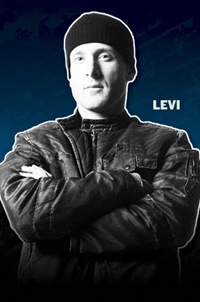
Like many cyclists, I have visited www.letleviride.com, the website Trek created with the surefire plan that a petition would get ASO to change its mind about letting Astana ride in the Tour de France (because, as you know, ASO is a highly rational race promoter and is always interested in hearing opposing points of view).
And, like many cyclists, I have been struck by the centerpiece of the website. No, it’s not the petition. No, it’s not that there’s no other real content besides the petition.
It’s that photo of Levi. He looks so…so…angry, with his dock-worker’s hat, his piercing stare, his leather jacket. His aggressively closed-off body language, expressed primarily in the form of folded arms.
He’s so angry, in fact, that while the rest of the website is in color, Levi has gone completely desaturated.
 I hardly ever get that angry.
I hardly ever get that angry.
Now, my first thought, upon seeing this picture was that Levi — a spokesman for PETA (see how kind, happy, and unlikely to beat you up he used to look?) – was angry that somebody made him wear a leather jacket for the photo shoot.
I’ve since discovered to reconsider.
Now the World is Ready for You
So last night I spent some time surfing the web, and I discovered that the Astana cycling team now has its very own website, making them as technologically with-it as the average American elementary school student. While there (at the Astana website, not elementary school), I ran across another picture of Levi.
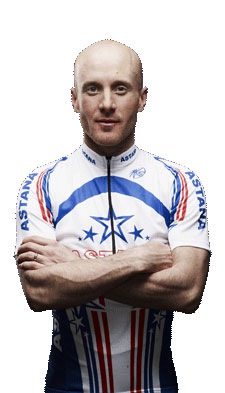 Yes, his arms are folded. Again.
Yes, his arms are folded. Again.
Or is it that they’re folded still?
I can’t help but begin to wonder what this means. Is it possible that Johan Bruyneel is forcing Levi to keep his arms folded at all times, so as to facilitate upper-body atrophy? Or is this a special training exercise that Levi is conducting, wherein he constantly squeezes his ribs in toward the center, eventually narrowing his body and reducing his wind footprint ever-so-slightly?
Well, those may be part of the explanation. But — for Levi, at least — part of the explanation may also have to do with the jersey he’s got on.
Tell me: if you had a jersey that looks like it was designed by the same cartoonist who penned Wonder Woman, wouldn’t you cross your arms over your chest?
Think I’m a little “out there?” OK, fine. Here’s another picture of Levi in this jersey design.
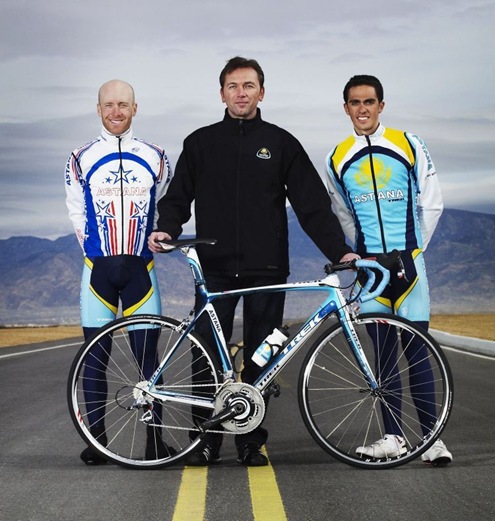
Sure, this time he’s not crossing his arms over his chest this time, but just look at his face. Have you ever seen more of a “Please, kill me now” smile in your life?
I submit that you have not.
More Proof
My interest — and my concern — growing, I started seeing if there is a pattern. I looked up Chris Horner’s picture:
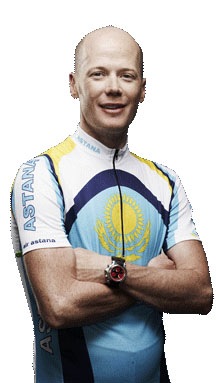
Yes, his arms are folded, too. If this had been the first Astana cyclist’s photo I had stumbled across, I would have centered my arm-folding Astana team theory around the fact that it looks like Chris is embarrassedly hiding a paunch. Look at that smile. It’s like he’s saying, “Hey, don’t look at my stomach. Why don’t you look at my head-sized watch, instead?”
Of course, Leipheimer and Horner are probably the only two Astana guys posing with their arms folded in front of them. It’s probably just some American thing, right?
Ha. Here are Sergey Ivanov and Andread Kloden, looking like they’re about to demand you hand over your lunch money.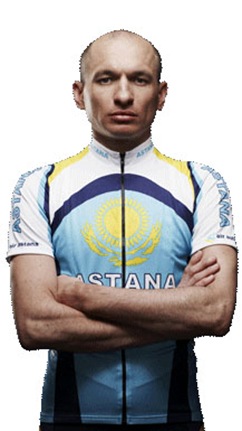
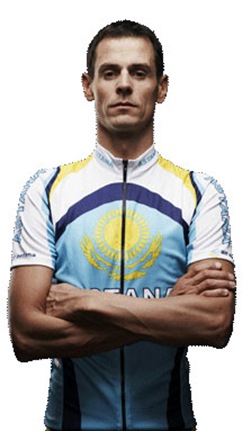
The Spaniards — Contador and Antonio Colom, are clearly going for the same look, though I’d say with considerably less success.
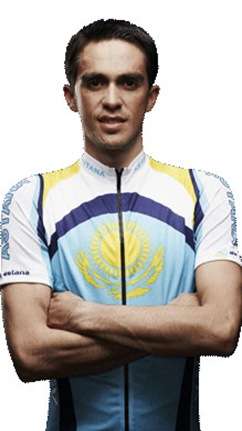
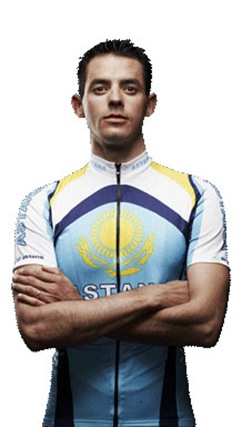
Explanations
Clearly, this is no coincidence. There’s a pattern here. “But,” I asked myself, over and over, “Why? Why would they be covering their chests like this?”
And then it hit me: By considering what they’re covering up, I could understand why they’re covering up.
I see two possibilities. One of the two must be true, and maybe both are.
Possibility 1: They’re covering up the name of the team with their arms, hoping that ASO will forget that they’re Astana. If you look at Contador — the racer who has the most to gain by getting in the good graces of ASO — you’ll notice he is by far the most proficient at covering up his team’s name.
Possibility 2: They’re covering up their hands. Is it possible that Bruyneel has been handing out beatings when cyclists turn in a less-than-stellar performance? In days of yore, headmasters would whack truant children on the top of the hand with a yardstick, leaving a painful — and very visible — bruise. Could it be that Bruyneel’s secret of success is a literal interpretation of “carrot and stick” motivational techniques?
Take a look at how few hands you see in all these photos — including the ones where Contador and Leipheimer are standing with Bruyneel, their hands behind their backs — and then try to tell me you don’t share my suspicions.
Or is it possible they’ve got other reasons? I’ll let you be the judge.
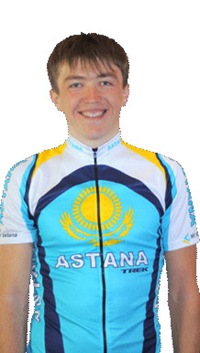 One Last Piece of Evidence
One Last Piece of Evidence
Let me conclude by showing you a picture of Roman Kireyev, off Kazakhstan. Here is his actual team member information:
- Favorite Race: World Championships
- Dream Profession: Actor
- Favorite City: Rome
- Message to Fans: Like cycling and have fun
- Favorite Food: Italian Pasta
That’s so sweet.
Personally, I find it offensive that Astana is evidently hiring 10-year-olds to race. Doesn’t that break some kind of child labor laws?
That doesn’t compare with my main complaint, though. Evidently, they’ve cut off his hands.
Bruyneel, have you no shame?
Comments (45)
04.9.2008 | 3:00 pm
A Note from Fatty: I’ve got a new article at BikeRadar today. You can read a snippet below, or click here to read the whole thing.
Dear Trek Bicycle Corporation and Mr. Greg Lemond,
You don’t need me to tell you that this is a difficult time in your lives. After being married for so long, separating is unbelievably difficult for all parties involved. You’re both feeling hurt, perhaps even betrayed. It’s natural that you would want to strike out at each other.
With this in mind, I would like to commend the two of you for coming to me for mediation, rather than settling this in divorce court. By doing this, you’re showing you’re willing to behave like adults and move on with your respective lives.
Having taken a look at what matters to each of you, I would like to propose the following as a first step in the negotiation process. If everyone is up front about what really matters to them, and is willing to make reasonable compromises, this negotiation can be equitable and relatively painless.
What Trek Gets
- Lance Armstrong’s Peace of Mind: First and foremost, Trek receives a guarantee that Mr. Lemond will never ever ever ever use any combination of the words "Lance," "Armstrong," or "dope" (or any of their synonyms) within three minutes of each other. Not in public. Not in private. Not by doing charades or meaningfully-raised eyebrows. From now on, in fact, Mr. Lemond promises to pretend he has simply never heard of Lance Armstrong, and will act pleasantly surprised to hear that another American has also won the Tour de France. If Mr. Lemond crosses this line even once, Trek may — at its own expense — use whatever combination of shock therapy, hypnotherapy and surgery it deems necessary to literally remove any recollection of Armstrong from Mr. Lemonds memory.
Click here to continue Reading "Mediating the Trek / Lemond Divorce" over at BikeRadar.com.
Comments (18)
04.8.2008 | 10:33 am
I want to start today’s post by stating that I do not report to Alex, a coworker of mine. He does not affect my salary, and he does not have the ability to fire me. He doesn’t have any sway over whether I ever get a raise or bonus.
So, now that I’ve established that I have no reason to brown-nose Alex, I would like to state, for the record, that he is a genius. Why would I make this bold — some would say "audacious," but I believe that this word has recently been trademarked — claim?
Because he has devised what I believe to be the best Jersey Pocket Food (JPF) that has ever been created.
JPF Qualifications
To be a true JPF, the item must — at a bare minimum — fit in a jersey pocket, and be food.
Simple enough, right?
Well, not so fast, Buster. It may not take much to be a JPF, but being a really great JPF requires so much more. Here are some of the attributes of a really great JPF:
- Easily Edible: Simply being food is kind of a low bar to clear in a JPF. Even the original PowerBars are a JPF by this metric, albeit barely. Easily edible means that you can, while still riding, reach back into your pocket, get the JPF out, remove the packaging, chew and swallow, all while still breathing and hopefully without wrecking. By this more stringent metric, very few foods qualify as a good JPF.
- Delicious: During a long ride, do you actually look forward to eating your JPF? Or does your stomach clench up and you find an excuse to go for another 20 minutes without eating? Your food is not a good JPF if you are reluctant to eat it.
- Highly Available: Suppose you’re in Hurricane (pronounced "HURR-uh-kuhn), Utah, about to spend the day riding Gooseberry Mesa. You need to buy food at the teeny-tiny grocery store there. Will you be able to get your favorite JPF there?
- Good Calorie Mix: Does your JPF have carbs, protein and fat? In other words, is it going to just power you for fifteen minutes, or does it have some legs to it?
Well, the JPF Alex suggested to me a couple of days is all of these. And it’s elegantly simple, too.
You’re probably wishing I’d just finally tell you what it is, aren’t you? Well, too bad. I’m not going to.
Just kidding.
The Ultimate JPF
I’m almost reluctant to reveal the ultimate JPF, because now that I know about it, it seems almost ridiculously obvious, like I should have been doing this all along.
But I haven’t been, and I’ll bet you haven’t been, either. So bear that in mind when I — finally — reveal that the ultimate JPF is:
Avocado, sliced onto and folded into a piece of white bread, kept in a sandwich bag.
You may be tempted to add condiments — mayo, etc. Don’t. You don’t need them, and condiments go bad fast.
Yes, that’s really all there is to it. Consider, though:
- It’s easy to get to.
- It’s easy to chew.
- White bread holds together and kind of sticks to itself and the avocado, keeping all together.
- It’s incredibly delicious, even after — no, make that especially after — riding for hours. I tested this last weekend.
- It’s got carbs, the right kind of fat, and protein.
- It’s delicious. In fact, it is widely known that the avocado is the most delicious food in the whole world.
I haven’t tried this on a 5+ hour ride yet, but I plan to this weekend. I can hardly wait.
Try it and let me know what you think. I’ll be happy to forward your praise along to Alex.
PS: Take a Survey, Help a Good Cause: A Fat Cyclist reader is conducting a survey about bike rack accessories. He’s said that he’ll donate $5.00 to the Lance Armstrong Foundation for every survey — up to 200 of them — Fat Cyclist readers do. I went ahead and took it, and found it pretty interesting. So why don’t you click here to take the survey? You’ll be helping a guy make a decision whether to go into business for himself, and you’ll be donating toward a good cause. Thanks!A big "Thank you" goes to everyone who’s taken the survey; more than 600 of you have taken the it, and he’s donated $1000 to the LAF. He got good data from his target demographic, you helped a guy with an interesting idea, and LAF got more money to help people with cancer.
Comments (103)
04.7.2008 | 9:06 pm
Things you can find around the house that you can eat while on the bike
Dietary benefits
Wallet benefits
Cost over time: easily enough to buy a new bike, or to pick up a new habit, or to just buy more beer.
Grossout benefits
Comments Off
« Previous Page — « Previous Entries Next Entries » — Next Page »










